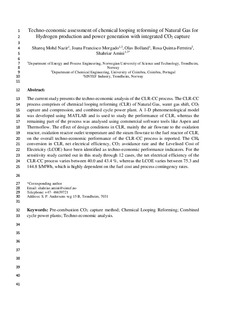| dc.contributor.author | Nazir, Shareq Mohd | |
| dc.contributor.author | Francisco Morgado, Joana | |
| dc.contributor.author | Bolland, Olav | |
| dc.contributor.author | Quinta-Ferreira, Rosa | |
| dc.contributor.author | Amini, Shahriar | |
| dc.date.accessioned | 2019-05-20T10:50:30Z | |
| dc.date.available | 2019-05-20T10:50:30Z | |
| dc.date.created | 2018-08-02T12:36:42Z | |
| dc.date.issued | 2018 | |
| dc.identifier.citation | International Journal of Greenhouse Gas Control. 2018, 78 7-20. | nb_NO |
| dc.identifier.issn | 1750-5836 | |
| dc.identifier.uri | http://hdl.handle.net/11250/2598011 | |
| dc.description.abstract | The current study presents the techno-economic analysis of the CLR-CC process. The CLR-CC process comprises of chemical looping reforming (CLR) of Natural Gas, water gas shift, CO2 capture and compression, and combined cycle power plant. A 1-D phenomenological model was developed using MATLAB and is used to study the performance of CLR, whereas the remaining part of the process was analysed using commercial software tools like Aspen and Thermoflow. The effect of design conditions in CLR, mainly the air flowrate to the oxidation reactor, oxidation reactor outlet temperature and the steam flowrate to the fuel reactor of CLR, on the overall techno-economic performance of the CLR-CC process is reported. The CH4 conversion in CLR, net electrical efficiency, CO2 avoidance rate and the Levelised Cost of Electricity (LCOE) have been identified as techno-economic performance indicators. For the sensitivity study carried out in this study through 12 cases, the net electrical efficiency of the CLR-CC process varies between 40.0 and 43.4%, whereas the LCOE varies between 75.3 and 144.8 $/MWh, which is highly dependent on the fuel cost and process contingency rates. | nb_NO |
| dc.language.iso | eng | nb_NO |
| dc.publisher | Elsevier | nb_NO |
| dc.rights | Attribution-NonCommercial-NoDerivatives 4.0 Internasjonal | * |
| dc.rights.uri | http://creativecommons.org/licenses/by-nc-nd/4.0/deed.no | * |
| dc.title | Techno-economic assessment of chemical looping reforming of natural gas for hydrogen production and power generation with integrated CO2 capture | nb_NO |
| dc.type | Journal article | nb_NO |
| dc.type | Peer reviewed | nb_NO |
| dc.description.version | acceptedVersion | nb_NO |
| dc.source.pagenumber | 7-20 | nb_NO |
| dc.source.volume | 78 | nb_NO |
| dc.source.journal | International Journal of Greenhouse Gas Control | nb_NO |
| dc.identifier.doi | 10.1016/j.ijggc.2018.07.022 | |
| dc.identifier.cristin | 1599462 | |
| dc.description.localcode | © 2018. This is the authors’ accepted and refereed manuscript to the article. Locked until 1.8.2020 due to copyright restrictions. This manuscript version is made available under the CC-BY-NC-ND 4.0 license http://creativecommons.org/licenses/by-nc-nd/4.0/ | nb_NO |
| cristin.unitcode | 194,64,25,0 | |
| cristin.unitname | Institutt for energi- og prosessteknikk | |
| cristin.ispublished | true | |
| cristin.fulltext | preprint | |
| cristin.qualitycode | 2 | |

